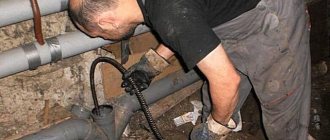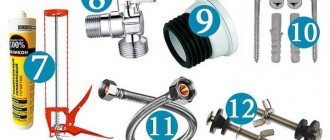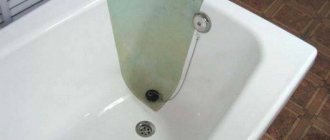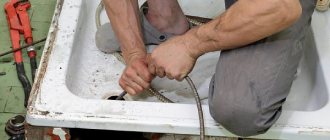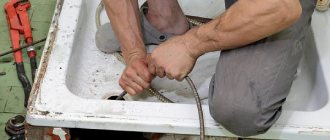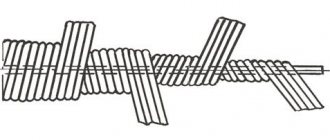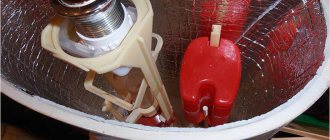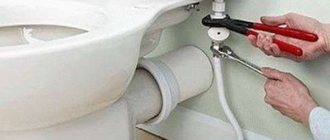- Causes of cracks in the toilet
- What to do to prevent cracks from appearing on the toilet and cistern
- Where do cracks mainly form on the toilet?
- Ways to get rid of cracks
Modern earthenware is made of quite high quality, so it lasts for many years, but the well-known property of ceramics is great fragility. With a certain mechanical impact or impact, plumbing fixtures can be damaged, so we all sometimes face the question of how to repair a crack in a toilet. In this article we will try to understand this issue in detail.
The main causes of cracks in the toilet tank
Plumbers identify three common causes of damage to toilet cisterns;
- mechanical impact;
- installation errors;
- temperature changes.
Toilets are made mainly from earthenware or porcelain. Both materials have increased maintenance requirements. Therefore, regardless of operating conditions, toilets begin to leak over time. In some cases, it is impossible to eliminate defects using the methods described. This, in particular, applies to large fractures in the base of the bowl.
The last plumbing defect is not recommended to be eliminated using improvised means. In this case, you should replace the broken toilet with a new one.
Mechanical influences
Chips, cracks and other damage to the toilet occur when any dense object falls onto the plumbing fixture from a sufficient height. Often, defects arise from even a bottle of shaving foam hitting earthenware or porcelain. In this regard, it is recommended to install cabinets in which household chemicals and other items are stored, if possible, away from the toilet.
Temperature difference
Cold water is used to flush the toilet. This choice is due to several reasons (including saving on utility costs). When exposed to hot water, earthenware and porcelain begin to expand. Moreover, this process occurs only in a certain zone. Due to uneven expansion, stress occurs within the material, resulting in cracks.
Installation defects
When tightening the bolts holding both the toilet and individual parts of the plumbing, it is not recommended to use excessive force. Because of this (against the background of increased pressure exerted by the fastening element), tension also arises inside the material, as a result of which porcelain and earthenware become covered with cracks.
See also
Instructions on how to install lamps in a suspended ceiling with your own hands
Which glue to choose?
It is known from practice that to securely fasten ceramic fragments, you can use so-called liquid nails.
If you need to restore the drain tank, then the gluing technology is exactly the same. Sanitaryware and porcelain adhere well to ready-made compounds, which are freely sold in the retail chain.
Among them, we must mention the BF-2 glue, which has proven itself for a long time and has proven itself. The abbreviation BF stands for “butyralphenol”.
The numerical value indicates the percentage of polyvinyl buteral. The higher the number, the higher the elasticity of the adhesive joint. Therefore, BF-6 is not suitable for gluing a toilet bowl.
In order to glue a toilet bowl or cistern, you can use epoxy resin. It glues reliably, but handling it is not very convenient.
It is preferable to use Rapid or Unicum glue. Any of these compounds can also be used to glue the toilet seat together.
In the process of choosing an adhesive composition, each master has to rely on his own experience and advice from those closest to him.
Often you have to prepare such a composition yourself from individual components.
Using liquid nails, you can prepare a high-quality adhesive mixture by adding chalk and a little quicklime. At the same time, you need to know that this composition “sets” very quickly.
It is prepared immediately before gluing. During the gluing process, excess composition must be immediately removed using a rag or soft cloth.
As practice shows, cracks or chips on the toilet often occur. No one living in the apartment is insured against such a nuisance.
Video:
If the seat is cracked, it is easier to replace it than to glue it. The glued toilet will, of course, still serve for some time.
At the same time, we must remember that the restored plumbing fixture (including the tank) no longer has its original strength.
And after some time it will have to be replaced with a new one.
How to glue correctly at home
Difficulty in gluing a toilet cistern arises due to the fact that cracks and chips on the surface of earthenware and porcelain do not have a smooth texture. Because of this, the adhesive composition holds the parts of the broken device together less well. Therefore, this procedure often has to be carried out two or more times.
What you will need
To glue porcelain and earthenware products you will need:
- fine sandpaper;
- acetone (gasoline), which is needed to remove grease from the toilet;
- glue;
- scotch.
You will also need wipes to remove excess adhesive. Before you begin gluing, you must turn off the water supply and drain the tank.
Surface preparation
The procedure for preparing the surface for restoration work depends on the nature of the defect. This procedure will require more effort for deep cracks that run on both sides of the tank.
Unilateral damage
In case of one-sided damage, the cracks must first be cleaned of dirt (a brush with stiff bristles is suitable for this), and then wiped of grease using acetone or gasoline. Similar actions need to be carried out in relation to the breakaway part.
Bilateral cracks
Before you start cleaning the surface and gluing the tank, it is recommended to use a thin ceramic drill to make a hole at the end of the crack. This is necessary in order to prevent further divergence of the defect and splitting of the plumbing fixtures. Then you need to use a grinder to widen the crack and process the internal surfaces according to the described algorithm. Subsequently, the damaged area is repaired using two-component epoxy resin.
Bonding technology
The procedure for gluing earthenware and porcelain cutlery depends on the size of the defect. The algorithm within which this procedure is carried out is the same for all formulations used.
Universal waterproof adhesive
Adhesive compositions of this type are recommended to be used to eliminate defects in places that are not constantly in contact with water:
- the junction of the tank and the bowl;
- toilet rim;
- the outer side of the tank and others.
The gluing of the tank is carried out in three stages. First, debris and other foreign particles are removed. Then the material is cleaned of fat. And after that, glue is applied and the broken fragment is pressed. The period during which the material must be held is indicated in the instructions for the glue.
This method is suitable for restoring those parts of the toilet cistern that are not subject to increased stress.
Epoxy resin
Epoxy resin is used to seal one-sided cracks. This product removes defects better than all-purpose glue. To restore a damaged tank, you need to mix the two components of this product (hardener and resin) and apply it to the problem area. After this, you need to press the gluing area. In this case, any means will do, including tape. After the resin has hardened, it is recommended to clean the gluing area using fine sandpaper and felt.
See also
Reasons and what to do if the washing machine fills the tank with water and immediately drains it
Silicone sealant or liquid welding
Both products are suitable for repairing small cracks and gluing broken fragments. Surface preparation for this case is carried out according to a similar algorithm. If a sealant is used, then you first need to saturate the surfaces with silicone, removing the excess with a spatula, and then walk with a soapy hand, thereby smoothing the composition. This restoration option is convenient in that the tank can be used 20 minutes after completion of the manipulations.
Liquid welding gives the same result as sealant. This product must first be rolled out in your hands and then applied to problem areas, compacting it into the cracks. After the four hours required for the paste to harden, you need to sand the surface with sandpaper.
Final finishing
It is recommended to treat the surface with fine-grained sandpaper in each of the above cases. If the crack was large, then after sealing the gluing area should be painted over in the appropriate color. Otherwise, the area where the defect was located will stand out against the background of the rest of the tank.
It is recommended to seal the internal seam with tiled grout.
Bonding plumbing fixtures
Repair work involving gluing plumbing fixtures is simple. In this case, you must do everything carefully. It is not difficult to notice a crack on a toilet bowl. Damage appears on the tank due to mechanical stress. Some of the most dangerous damage is at the base of the toilet. Damage of this nature can increase, making it difficult to repair. The crack must be repaired immediately to extend the service life of the plumbing fixtures. If you follow all the rules of the experts, you can achieve success.
Subtleties of preparing the surface of the toilet
The first step is to start cleaning. The chip must be cleaned thoroughly and carefully. The work is carried out using sanding paper. After this, the surface must be thoroughly wiped to get rid of small particles. Degreasing allows the glue to adhere well to the material. In this regard, gasoline and acetone are suitable. You also need to evaporate moisture from the surface of the plumbing and warm it with a hairdryer. Preparation is the best option if the cracks are simple in shape.
In the case where the damage has a complex fault topography, a different procedure must be followed. In this regard, repair work requires the need to strongly trim the bulges
Plumbers warn that fractures of this shape must be handled with caution. Small debris should be blown out with a hairdryer
After this, the surface must be degreased and dried.
Seam gluing procedure
You can understand the procedure by studying the user manual that comes with the glue. If you follow the recommendations written in it, you can do everything correctly. Basically, the procedure is identical, it involves applying glue to the surface of the toilet and after it dries. Having completed everything, you need to firmly press the elements together. The result is affected by the compression force. This must be done as strongly as possible to achieve maximum seam strength. The use of an elastic tight tourniquet or clamp will help in this matter.
Final finishing procedure
Plumbers have determined an algorithm for performing work regarding the seam located inside the plumbing. In this regard, strengthening is a prerequisite. The dried seam must be cleaned using sandpaper. You need to degrease well and dry with a hairdryer. After completing this work, it is necessary to coat the seam with glue. The reinforcement is a padded strip of soft metal or thin plastic. After this, you need to thoroughly dry the area that was to be glued.
If the damage was outside, it should be treated with grout. Builders advise using grout designed for tile joints. If this is not available, then you can alternatively use a solution that contains epoxy resin. The compositions are available for sale in different shades, so you need to choose the most appropriate tone in relation to the product.
Review of ready-made formulations
Various means are used to eliminate defects in drain tanks. In addition to those described, liquid nails, which are applied according to the specified algorithm, help restore earthenware and porcelain products. Specialized products, such as Unicum, BF-2 or Rapid, can also cope with such defects.
BF-2
BF-2 is a universal adhesive that is used to restore various materials, including sanitary ware. When purchasing this product, you must pay attention to the labeling. A number of varieties of BF-2 are not suitable for gluing toilets.
Unique
One-component epoxy resin based on rubber and other additives. Unicum is characterized by increased resistance to temperature changes, but does not tolerate exposure to open fire.
Rapid
Another type of epoxy resin used to restore plumbing fixtures. Rapid, unlike Unicum, is suitable for eliminating defects on porcelain. This product dries completely within two days.
See also
The best ways to quickly repair a shoe sole if it bursts
Glue selection
The product that will be used to solve the problem with the toilet must have good adhesive strength. Therefore, preference should be given only to special mixtures, avoiding simple universal options that will quickly lose the stability of the compound when exposed to water. Perfect for this:
- glue (waterproof, silicate);
- cold welding;
- sealant (waterproof);
- epoxy resin with hardener;
- liquid Nails.
The products have similar properties, and some of them even have slightly similar composition. The last option differs most in terms of effectiveness - liquid nails will only help glue the toilet tank lid. They do not give the desired effect when gluing frequently used elements under high pressure.
It is recommended to purchase gluing products from trusted manufacturers who have managed to prove their reliability by producing high-quality products. It is recommended to buy one of the following brands:
- "Rapid";
- "Mars";
- "Moment Epoxylin";
- "Unicum";
- MC-1;
- BF-2;
- EDP;
- UHU Porzellan;
- EpoxyMax;
- Bliz Steel;
- "Poxipol";
- "Almaz-press".
If it is not possible to purchase glue for a broken toilet, you can prepare a special mixture for gluing yourself. This requires a few specific ingredients. However, the final result will not be worse. There are 3 main options for homemade solution:
- Mix borax, water and casein in a ratio of 1:2:10, add a couple of drops of formalin or aluminum alum, mix thoroughly. The mixture sets within two hours.
- Pour turpentine and light shellac into one container in a ratio of 1:2, put on fire. After melting, you need to mix everything well. When hardened, the mixture can be reheated before gluing.
- Mix chalk, quicklime and liquid glass in a ratio of 10:1:2.5. The mixture must be prepared immediately before installation, as it hardens quickly.
There are other folk recipes, one of which even uses crushed glass.
Recipes for homemade adhesives
For gluing porcelain and earthenware, you can prepare your own compositions from the following components (optional):
- 1 part glass to 2 parts sifted sand. Then add 6 parts sodium silicate.
- 1 part lime to 2 parts chalk and 2.5 sodium silicate. After mixing, the composition must be applied immediately.
- 1 part turpentine to 2 parts shellac. After mixing, the composition must be heated and then cooled. Before each use, the mixture should be melted over a fire.
- The gypsum is kept in alum for 24 hours. Then the composition is dried, calcined and divided into several parts. Next, each piece is diluted in water until a creamy mixture is obtained.
It is recommended to apply the above compositions to problem surfaces immediately after preparation.
What is needed for repair
The selection of adhesive for the toilet is a crucial moment on which the strength of the seam and the further use of plumbing depend.
How to choose glue
It is possible to glue the surface so that the seam is invisible. Silicate glue is often used, as it is resistant to water, temperature changes, has a long service life, and prevents the spread of fire.
To secure the seam, you can resort to using liquid nails. Ready-made adhesive mixtures are also purchased:
- BF-2 is a viscous reddish liquid containing an alcohol solution of polyvinyl acetate with a resin complex. Waterproof, does not form fungus or mold on the surface. The composition is flammable, for this reason it is necessary to operate away from direct flames and heat devices, in a thoroughly ventilated area. Bonds ceramics, glass, plastic, etc.
- Unicum is a one-component adhesive containing rubber and reinforcing additives. Scope of application: gluing ceramics, glass, leather, rubber, etc. viscous mass of beige color. The seam can withstand temperature changes from –40 to 70 degrees. Method of application: the surface of the toilet bowl is cleaned, the glue is applied in a thin layer, after 10 minutes a second layer is applied, after 10 minutes press the surfaces to be glued. The product is put into operation within half a day. The operating temperature should not be less than 10 degrees. The mixture is flammable, for this reason it is necessary to operate away from direct flames, heat devices, and in a thoroughly ventilated area.
- Rapid is an adhesive in the form of a solution of nitrocellulose with resins and organic diluents. Used for gluing leather, wood, porcelain. During operation, the planes are degreased, dried, a layer of glue is applied and dries for up to 20 minutes, after which a second layer is applied, the planes are pressed firmly and secured. Complete drying is achieved after two days.
Homemade adhesive composition
For the purpose of gluing a toilet bowl or toilet cistern, an adhesive mass is made independently. To do this you need to follow these recipes:
- Durable, but not easy to use, proportions: one part of crushed glass, two parts of sand (pre-sifted), six parts of sodium silicate.
- Durable, but hardens quickly, for this reason it is prepared directly before use, applied to cleaned surfaces: one part lime, ten parts chalk, two and a half parts sodium silicate.
- Glue mixture: one part turpentine, two parts shellac. Mix well, melt over low heat, cool. The mass is divided into parts. Melts before use. Apply a thin layer to the prepared surfaces, press tightly and fix. If excess mixture appears through a seam, it must be wiped off immediately.
- Gypsum composition: gypsum is soaked in alum for 24 hours. Afterwards it is dried, calcined, and crushed. To prepare the glue, the dry mixture is diluted with clean water until a creamy mass is formed.
Design features of the device
The microlift is sold together with the toilet lid, but it can also be purchased separately. Covers equipped with closers are made of plastic or its modern version - duroplast. Although this polymer looks like plastic in appearance, its quality characteristics are closer to ceramics.
Fix the device to the toilet in a rigid way. The main structural elements of the microlift:
- A rod that securely holds the rigid plastic installation.
- Spring to balance the weight of the structure.
- Hinged micro-lift mechanism that allows changing the position of the lid.
In more expensive functional systems, the basis of the mechanism is not springs and rods, but pistons and cylinders. Structures of this type are classified as non-removable.
Functional systems, in which seats and covers are supplemented with a built-in microlift, are produced by many manufacturers of sanitary equipment. If desired, you can purchase and install a universal system, which includes, in addition to the microlift, other devices.
They are capable of providing several functions at once:
- adjusting the temperature of incoming water;
- possibility of seat heating;
- high-quality washing, enema and massage;
- extraction of unpleasant odors followed by deodorization.
Many models are often equipped with a convenient self-cleaning function, thereby minimizing the participation of household members in the process of using the plumbing fixture. The presence of a microlift is just one way to make your living conditions more comfortable.
How to glue ceramic toilets and installations made of other materials
What are toilets made of? This question arises when the device needs repair, because in a modern well-appointed home it is impossible to do without this installation. If you believe the statistics, then, taking into account certain conditions, the device is used every 6-7 minutes.
Taking these circumstances into account, toilets are made from:
- Porcelain;
- Ceramics;
- Faience
- Become.
Toilet bowls require not only mechanical strength, but also the ability to withstand chemical influences. Speaking about devices that use ceramics, we can say that they are not only the most popular, but also the best among other products.
At the moment, people have extensive experience in installing and repairing toilets, but as practice shows, if the installation is carried out correctly, then there is no further operation. This is what leads to both partial and complete destruction of products.
Additional tips and tricks
When choosing an adhesive, you should be guided by what materials such compositions are suitable for. Universal products are not able to provide a sufficient level of adhesion. Therefore, it is recommended to use separate glue for ceramics, and a porcelain toilet bowl should be restored using the appropriate composition.
Modern earthenware is made of quite high quality, so it lasts for many years, but the well-known property of ceramics is great fragility. With a certain mechanical impact or impact, plumbing fixtures can be damaged, so we all sometimes face the question of how to repair a crack in a toilet. In this article we will try to understand this issue in detail.
Best answers
Maygli:
There are atrocious adhesives (China in a small package), dries in 10 seconds. This is only for the crack. He himself will infiltrate where necessary. Only this is needed freshly. No dirt. Try it, maybe it will catch, but the hole is empty. welding for ceramics.
e s:
replace
Roman Serdcev:
Transparent silicone will help you, you just need to dry the edges of the wound))) and degrease... At the same time, tape the cat’s butt so that he can go to his push)))
Michael:
silicone will not help, and it will turn out very rough. There is such a substance as a crystallizer. Used to fill cracks in ceramics and granite. the substance is transparent, similar to varnish. if it's expensive, try waterproof varnish. in both cases, dry and degrease the surface. Good luck!
Gulia:
call a plumber
Alexander Bakushev:
If it's inside the toilet, then it's better not to risk flooding your neighbors! borrow and buy a new one!
Mikhail Shirokov:
If you're not in good condition, you shouldn't cover up the hole, buy a new one, it'll be cheaper, believe me!
Truculentus:
Cold welding. But buying a branded one will keep it.
Heinrich Mont:
I wonder where people “with difficult financial situations” put the brush? For example, I have it near the toilet. Or is your cat trained to wipe the toilet behind itself with a brush? And then the paws slipped?
Work order
For preliminary surface preparation you will need materials: sandpaper, clean rags, degreaser.
First, the breakage site is cleaned with sandpaper. Then wipe with a clean cloth and degrease. The solvent used as a degreaser is acetone.
The surface is dried with a hairdryer. One of the split parts is coated with glue and immediately pressed against the second with maximum force (but you need to feel the pressing force so that further cracking does not occur). The interlocking parts are fixed.
These steps are used for gluing small chips and cracks. If a split occurs inside the toilet, it is better to use epoxy resin for gluing.
If the fragments occurred on the tank, then they can be sealed in the same sequence. Only the material of the tank is thinner and it undergoes gluing much faster.
When using resin for gluing, after sanding, the surface is wiped with felt material and dust is not allowed.
Precautionary measures
All of the above methods for fixing cracks are temporary. Each restoration may cause re-formation. To avoid additional cracks or chips, the following precautions are recommended:
- There should not be shelves with any objects above the toilet, as these objects can fall onto the surface and cause a fatal impact on the product.
- It is unacceptable to use construction tools near ceramics. If this is an unavoidable measure, it is carried out with extreme caution and the product is covered with soft cloth in several layers.
- Do not carry out additional fasteners after installing the toilet.
- Do not place unnecessary loads with massive objects.
Answers from experts
Sidorov Mikhail:
The side of my tank cracked all the way to the bottom. I put it on silicone and coated the wall inside and outside. Two years without problems. But I did it for a while, I thought I’d replace it later. No need.
Veronica Ivanova:
Cold welding
Torpedo boat base:
qualitatively - nothing
Roman Mikhailov:
Use epoxy resin, then rub the seam with zero and cover the top with a thin layer of enamel.
Demitros:
can be glued with liquid nails for plumbing
Izbiratel:
I assume that initially water was dripping or flowing there, and instead of unscrewing and changing the gaskets, you decided to clamp it... I bought another toilet!
Anton Antonenko:
Here
Lilya Kalide:
If “only silicone sealant,” then you lubricate the split with sealant and attach it. then you fill everything with this sealant from the floor and walls to the broken piece, allowing the layers of fill to set so that there is support. as glue the sealant is no good, but as a replacement for the support it might last for a while
Gda:
Someone climbed in with their feet...)))) Change.... or don't change it
Sergey Drozdov:
Previously, we did it ourselves, but now there seem to be adhesive mixtures containing liquid glass (especially for ceramics) on sale. You just need to look for them. All the fragments will stick together perfectly. In some magazine from “Young Technician” from the 80s there was a recipe for such glue. You can google old collections.
GT:
stick a piece of pipe into the tank with sealant and take it out into the toilet, the place where the degrease broke off and glue it to epoxy or silicone.
Vasilevich:
Glue this piece with EDR glue (epoxy resin), I fixed the sink this way, it’s been in use for 10 years now.
Vladimir Nikitin:
A broken toilet shelf under the cistern cannot be repaired. Replacing the toilet.
